Influence of Precipitation on Maize Yield in the Eastern United States
Abstract
:1. Introduction
2. Materials and Methods
2.1. Study Area
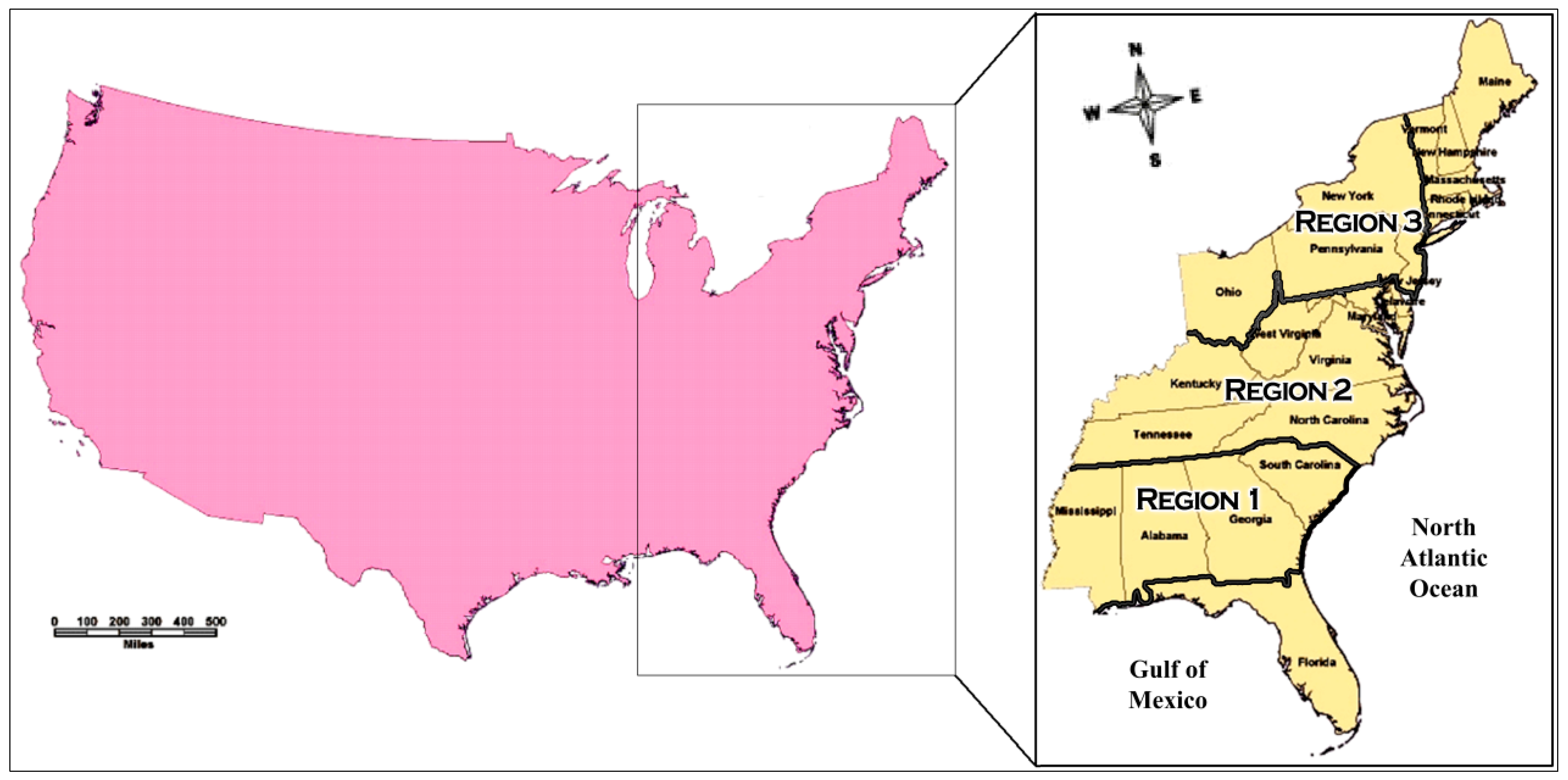
| Region | State | Average (mm) | Maximum Monthly (mm) | Minimum Monthly (mm) | Coefficient of Variation |
|---|---|---|---|---|---|
| Region 1 (maize growing season from March to September) | Alabama | 862 | 356 | 17 | 44% |
| Georgia | 786 | 313 | 16 | 44% | |
| Mississippi | 846 | 365 | 21 | 46% | |
| South Carolina | 783 | 275 | 19 | 44% | |
| Average | 819 | 365 | 16 | 44% | |
| Region 2 (maize growing season from April to October) | Delaware | 697 | 350 | 4 | 50% |
| Maryland | 685 | 280 | 4 | 46% | |
| Kentucky | 727 | 298 | 4 | 42% | |
| North Carolina | 776 | 338 | 3 | 42% | |
| Tennessee | 759 | 265 | 0.8 | 41% | |
| Virginia | 682 | 266 | 2 | 42% | |
| Average | 721 | 350 | 0.8 | 44% | |
| Region 3 (maize growing season from May to November) | New Jersey | 714 | 435 | 8 | 50% |
| New York | 678 | 216 | 8 | 34% | |
| Ohio | 632 | 233 | 6 | 40% | |
| Pennsylvania | 690 | 285 | 6 | 38% | |
| Average | 678 | 435 | 6 | 42% |
2.2. Data Sources and Statistical Analyses
3. Results
3.1. Precipitation Characteristics of Maize Growing Season
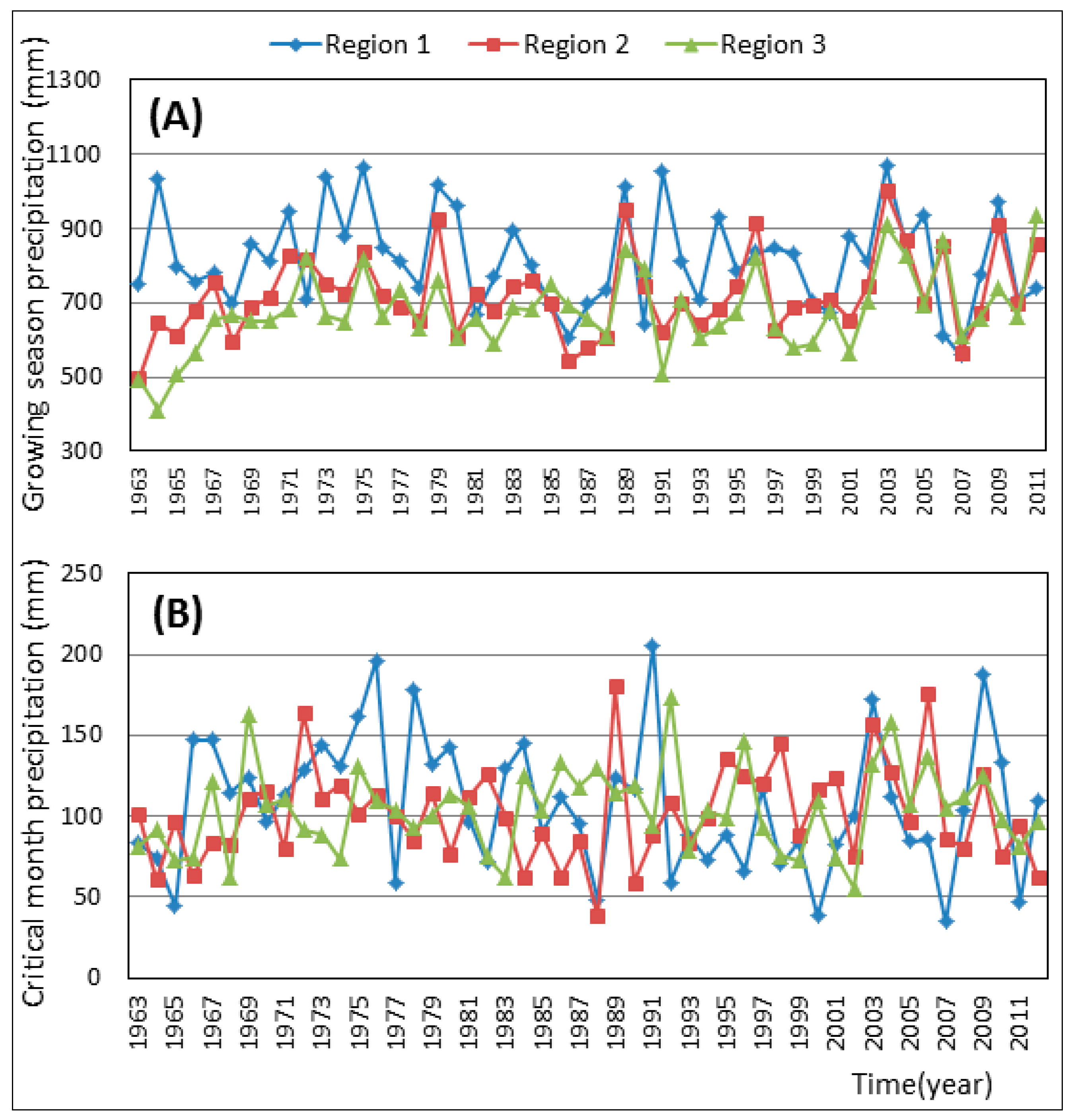
3.2. Maize Yield Trends
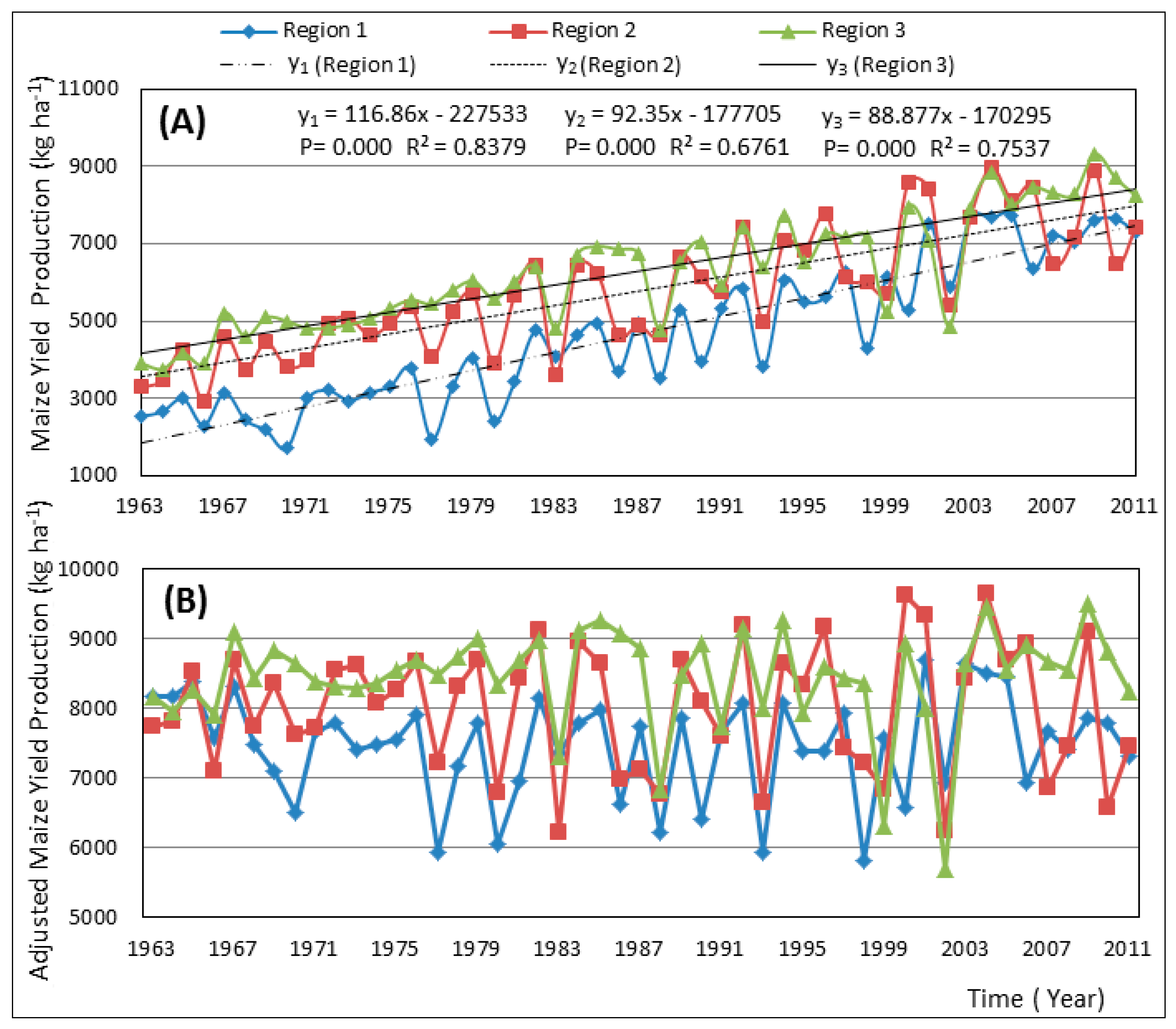
3.3. Precipitation-Maize Yield Relationships
3.3.1. Maize Yield-Precipitation Relationships at Regional Level
| Region | Regression Equation | P | R2 |
|---|---|---|---|
| Region 1 | Y = 1.7764x + 6008.2 | 0.027 | 0.099 |
| Region 2 | Y = 2.9582x + 5879.7 | 0.020 | 0.109 |
| Region 3 | Y = 1.9594x + 7109.3 | 0.046 | 0.082 |
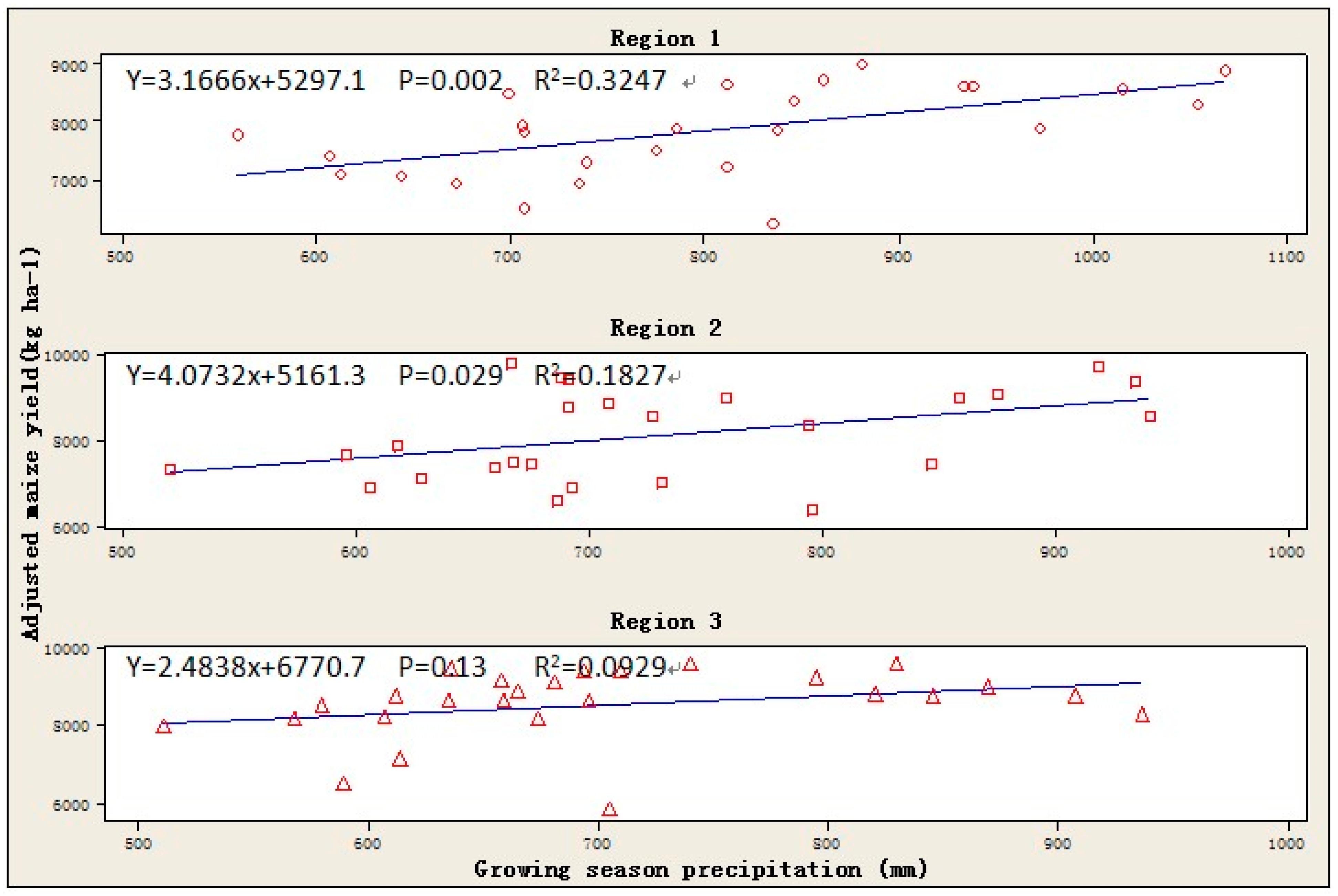
| Region | Regression Equation | p | R2 |
|---|---|---|---|
| Region 1 | Y = 3.0852x + 7131.3 | 0.228 | 0.031 |
| Region 2 | Y = 15.449x + 6428.2 | 0.000 | 0.258 |
| Region 3 | Y = 14.99x + 6876.4 | 0.000 | 0.301 |
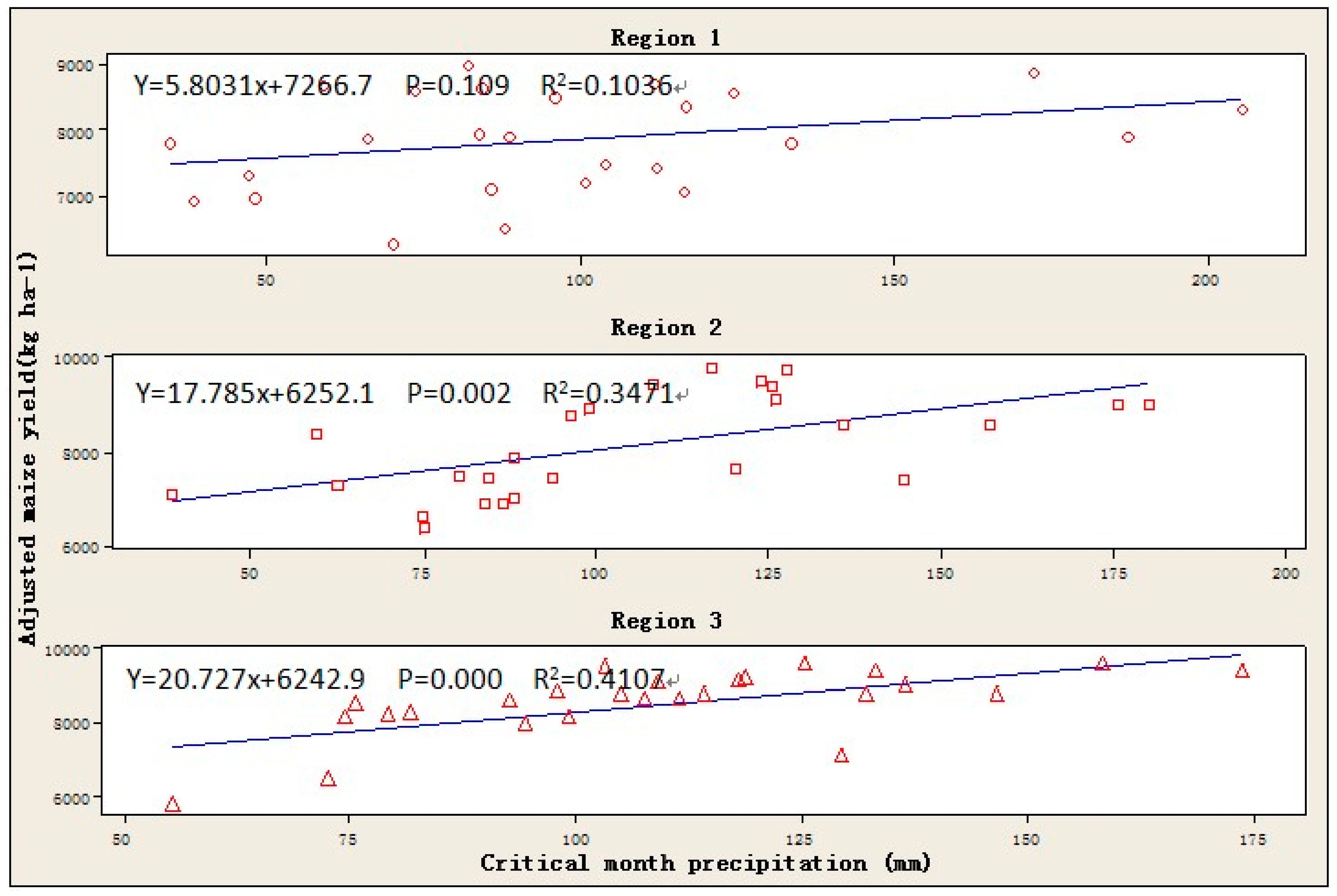
3.3.2. Maize Yield-Precipitation Relationships at State Level
| Region | State | Period | Regression Equation | p | R2 |
|---|---|---|---|---|---|
| Region 1 | Alabama | 1963–2011 | Y = 2.1315x + 4976.8 | 0.005 | 0.158 |
| 1986–2011 | Y = 3.7039x + 3933.5 | 0.001 | 0.377 | ||
| Georgia | 1963–2011 | Y = 2.1952x + 6861.2 | 0.01 | 0.132 | |
| 1986–2011 | Y = 2.4158x + 7385.6 | 0.005 | 0.283 | ||
| Mississippi | 1963–2011 | Y = −1.0583x + 9448.7 | 0.129 | 0.048 | |
| 1986–2011 | Y = 0.1193x + 8941.1 | 0.902 | 0.001 | ||
| South Carolina | 1963–2011 | Y = 3.4316x + 3209.9 | 0.01 | 0.133 | |
| 1986–2011 | Y = 5.0969x + 2128.3 | 0.021 | 0.204 | ||
| Region 2 | Delaware | 1963–2011 | Y = 2.8362x + 6632.3 | 0.013 | 0.125 |
| 1986–2011 | Y = 3.3357x + 6293.4 | 0.057 | 0.143 | ||
| Maryland | 1963–2011 | Y = 3.3147x + 5888.8 | 0.005 | 0.157 | |
| 1986–2011 | Y = 4.1137x + 5425.6 | 0.22 | 0.200 | ||
| Kentucky | 1963–2011 | Y = 2.0501x + 7417.2 | 0.046 | 0.082 | |
| 1986–2011 | Y = 2.2939x + 7504.7 | 0.071 | 0.130 | ||
| North Carolina | 1963–2011 | Y = 2.5844x + 4699.5 | 0.025 | 0.102 | |
| 1986–2011 | Y = 2.7872x + 4683.2 | 0.081 | 0.121 | ||
| Tennessee | 1963–2011 | Y = 2.65x + 6421.8 | 0.005 | 0.156 | |
| 1986–2011 | Y = 3.3481x + 5908.9 | 0.005 | 0.281 | ||
| Virginia | 1963–2011 | Y = 4.735x + 4016.3 | 0.001 | 0.228 | |
| 1986–2011 | Y = 5.7514x + 3328.4 | 0.006 | 0.279 | ||
| Region 3 | New Jersey | 1963–2011 | Y = 0.9469x + 7155 | 0.399 | 0.015 |
| 1986–2011 | Y = 1.7361x + 6349.2 | 0.378 | 0.033 | ||
| New York | 1963–2011 | Y = 0.6157x + 7835.1 | 0.389 | 0.016 | |
| 1986–2011 | Y = 0.6803x + 7986 | 0.597 | 0.012 | ||
| Ohio | 1963–2011 | Y = 1.9521x + 8563.1 | 0.104 | 0.055 | |
| 1986–2011 | Y = 3.0991x + 7951.2 | 0.09 | 0.115 | ||
| Pennsylvania | 1963–2011 | Y = 2.8929x + 5869.7 | 0.013 | 0.125 | |
| 1986–2011 | Y = 2.8143x + 5987.5 | 0.116 | 0.100 |
| Region | State | Period | Regression Equation | p | R2 |
|---|---|---|---|---|---|
| Region 1 | Alabama | 1963–2011 | Y = 3.676 x + 6387.9 | 0.122 | 0.050 |
| 1986–2011 | Y = 6.4583 x + 6356.5 | 0.072 | 0.129 | ||
| Georgia | 1963–2011 | Y = 3.3058 x + 8278.5 | 0.244 | 0.029 | |
| 1986–2011 | Y = 5.0053 x + 8849.2 | 0.203 | 0.067 | ||
| Mississippi | 1963–2011 | Y = −1.1608 x + 8702.6 | 0.521 | 0.009 | |
| 1986–2011 | Y = 0.7804 x + 8942.8 | 0.741 | 0.005 | ||
| South Carolina | 1963–2011 | Y = 7.0327 x + 5242.8 | 0.118 | 0.051 | |
| 1986–2011 | Y = 9.9701 x + 5209.3 | 0.311 | 0.043 | ||
| Region 2 | Delaware | 1963–2011 | Y = 10.136x + 7645.2 | 0.006 | 0.148 |
| 1986–2011 | Y = 13.627x + 7370.1 | 0.009 | 0.251 | ||
| Maryland | 1963–2011 | Y = 9.465x + 7237.8 | 0.007 | 0.147 | |
| 1986–2011 | Y = 15.844 x + 6778.1 | 0.004 | 0.292 | ||
| Kentucky | 1963–2011 | Y = 6.4777 x + 8219.2 | 0.066 | 0.070 | |
| 1986–2011 | Y = 4.3095x + 8680 | 0.337 | 0.038 | ||
| North Carolina | 1963–2011 | Y = 17.144x + 4766.4 | 0.000 | 0.503 | |
| 1986–2011 | Y = 17.554x + 4854.6 | 0.000 | 0.570 | ||
| Tennessee | 1963–2011 | Y = 5.3704x + 7857.1 | 0.067 | 0.070 | |
| 1986–2011 | Y = 7.0461x + 7633.1 | 0.046 | 0.156 | ||
| Virginia | 1963–2011 | Y = 15.995x + 5713.5 | 0.000 | 0.250 | |
| 1986–2011 | Y = 21.43x + 5198 | 0.001 | 0.353 | ||
| Region 3 | New Jersey | 1963–2011 | Y = 13.577x + 6326.9 | 0.000 | 0.289 |
| 1986–2011 | Y = 24.122x + 4850.5 | 0.000 | 0.447 | ||
| New York | 1963–2011 | Y = 3.5821x + 7906.5 | 0.158 | 0.042 | |
| 1986–2011 | Y = 4.5763x + 7984 | 0.242 | 0.057 | ||
| Ohio | 1963–2011 | Y = 11.739x + 8571.8 | 0.005 | 0.156 | |
| 1986–2011 | Y = 15.199x + 8306.1 | 0.014 | 0.225 | ||
| Pennsylvania | 1963–2011 | Y = 19.047x + 5863 | 0.000 | 0.383 | |
| 1986–2011 | Y = 21.455x + 5663.9 | 0.000 | 0.408 |
4. Discussion
5. Conclusions
Acknowledgments
Author Contributions
Conflicts of Interest
References
- Claudia, T.; Katharine, H.; Julie, M.A.; Gerald, A.M. Going to the extremes an intercomparison of Model- Simulated listorical and future changes in extreme events. Clim. Chang. 2006, 79, 185–211. [Google Scholar] [CrossRef]
- Raymond, G.N.; Christopher, R.P.; Mary, B.A.; Denise, B.; Carl, H.; Michael, K.; Robert, H.; Margaret, R.M.; Michael, P.; David, S.; et al. Potential climate-change impacts on the Chesapeake Bay. Estuarine Coast. Shelf Sci. 2010, 86, 1–20. [Google Scholar] [CrossRef]
- Dawson, J.; Scott, D. Systems Analysis of Climate Change Vulnerability for the US Northeast Ski Sector. Tour. Hosp. Plan. Dev. 2010, 7, 219–235. [Google Scholar] [CrossRef]
- Vivian, K.A. Behavioral Adaptation of Skiers and Snowboarders in the US Northeast to Climate Variability and Change. Master’s Thesis, University of Waterloo, Waterloo, ON, Canada, 2011. [Google Scholar]
- Andrew, R.; Charlotte, B.; David, A.; Denice, W.; James, S.; Marc, M.; Matthew, R.; Raymond, N.; Richard, R.; Seth, B.; et al. Pennsylvania Climate Impacts Assessment Update; The Pennsylvania State University: University Park, PA, USA, 2012; pp. 6–18. [Google Scholar]
- Allison, M.T.; Robert, A.B.; Norman, J.R. Climate change impacts for the conterminous USA: An integrated assessment, Part 4: Water resources. Clim. Chang. 2005, 69, 67–88. [Google Scholar] [CrossRef]
- Rachel, H.; Steve, A.; Peter, B.; Jerry, H.; Anthony, J.L.; Mike, G.R.; David, S.; Margaret, W. The Effects of Climate Change on U.S. Ecosystems. Available online: http://www.usda.gov/img/content/EffectsofClimateChangeonUSEcosystem.pdf (accessed on 29 April 2015).
- USDA-National Agricultural Statistics Service. Available online: http://www.nass.usda.gov/ (accessed on 29 April 2015).
- Food and Agriculture Organization of the United Nations. Statistics Division. Available online: http://www.fao.org/statistics/en/ (accessed on 29 April 2015).
- Hall, A.J.; Vilella, F.; Trapani, N.; Chimenti, C.A. The effects of water stress and genotype on the dynamics of pollen-shedding and silking in maize. Field Crops Res. 1982, 5, 349–363. [Google Scholar] [CrossRef]
- Bacsi, Z.; Thornton, P.K.; Dent, J.B. Impacts of future climate change on Hungarian crop production: An application of crop growth simulation models. Agric. Syst. 1991, 37, 435–450. [Google Scholar] [CrossRef]
- Tollenaar, M.; Dwyer, L.M.; Stewart, D.W. Ear and kernel formation in maize hybrids representing three decades of grain yield improvements in Ontario. Crop Sci. 1992, 32, 432–438. [Google Scholar] [CrossRef]
- Downing, T.E. (Ed.) Climate Change and World Food Security NATO ASI Series I: Global Environmental Change 37; Spring: Berlin, Germany, 1996; p. 662.
- Watson, R.; Zinyowera, M.; Moss, R. (Eds.) Climate change 1995: Impacts, adaptation and mitigation of climate change. In Contribution of Working Group II to the Second Assessment Report of the IPCC; Cambridge University Press: Cambridge, UK, 1996.
- Gommes, R. Climate Related Risk in Agriculture. Available online: http://www.fao.org/uploads/media/climrisk.pdf (accessed on 29 April 2015).
- Andrade, F.H.; Vega, C.; Uhart, S.; Cirilo, A.; Cantarero, M.; Valentinuz, O. Kernel number determination in maize. Crop Sci. 1999, 39, 453–459. [Google Scholar] [CrossRef]
- Burhan, O.; Handan, A. Impacts of climate factors on yields for selected crops in Southern Turkey. Mitig. Adapt. Strateg. Glob. Chang. 2002, 7, 367–380. [Google Scholar] [CrossRef]
- Adams, R.M.; Wu, J.; Houston, L. Climate Change and California, Appendix IX: The effects of Climate Change on Yields and Water Use of Major California CROPS. Available online: http://www.energy.ca.gov/reports/500-03-058/2003-10-31_500-03-058CF_A09.PDF (accessed on 29 April 2015).
- Lobell, D.B.; Cahill, K.N.; Field, C.B. Historical eddects of temperature and precipitation on California crop yields. Clim. Chang. 2007, 81, 187–203. [Google Scholar] [CrossRef]
- Kovaţeviš, V.; Jolankai, M.; Birkas, M.; Lonţariš, Z.; Ńońtariš, J. Influences of precipitation and temperature trend on maize yields. In Proceedings of the 44th Croatian and 4th International Symposium on Agriculture, Opatija, Croatia, 16–20 February 2009; pp. 541–545.
- Sun, H.Y.; Shen, Y.J.; Yu, Q.; Gerald, N.F. Effect of precipitation change on water balance and WUE of the winter wheat- summer maize rotation in the North China Plain. Agric. Water Manag. 2010, 97, 1139–1145. [Google Scholar] [CrossRef]
- Daniel, U.; Michael, J.R.; Wolfram, S. Projected temperature changes indicate significant increase in interannual variability of U.S. maize yields. J. Clim. Chang. 2012, 112, 525–533. [Google Scholar] [CrossRef]
- Andresen, J.A.; Alagarswamy, G.; Ritchie, J.T.; Rotz, C.A.; LeBaron, A.W. Assessment of the impact of weather on maize, soybean, and alfalfa production in the Upper Great Lakes Region of the United States, 1895–1996. Agron. J. 2001, 93, 1059–1070. [Google Scholar] [CrossRef]
- Hu, Q.; Buyanovsky, G. Climate effects on corn yield in Missouri. J. Appl. Meteorol. 2003, 42, 1626–1635. [Google Scholar] [CrossRef]
- Wilhelm, W.W.; Wortmann, C.S. Tillage and rotation interactions for corn and soybean grain yield as affected by precipitation and air temperature. Agron. J. 2004, 96, 425–432. [Google Scholar] [CrossRef]
- Malone, R.W.; Ma, L. N Uptake Affects Model (RZWQM). In New Advances in Understanding and Quantification of Plant N Uptake; Ma, L., Bruulsema, T., Ahuja, L., Eds.; CRC Press: Boca Raton, FL, USA, 2009; pp. 259–275. [Google Scholar]
- Nielsen, D.C.; Vigil, M.F.; Benjamin, J.G. The variable response of dryland corn grain yield to soil water content at planting. Agric. Water Manag. 2009, 96, 330–336. [Google Scholar] [CrossRef]
- Nielsen, D.C.; Halvorson, A.D.; Vigil, M.F. Critical precipitation period for dryland maize production. Field Crops Res. 2010, 118, 259–263. [Google Scholar] [CrossRef]
- Campbell, C.A.; Janzen, H.H.; Paustian, K.; Gregorich, E.G.; Sherrod, L.; Liang, B.C.; Zentner, R.P. Carbon storage in soils in the North American Great Plains: Effect of cropping frequency. Agron. J. 2005, 97, 349–363. [Google Scholar] [CrossRef]
- Nielsen, D.C.; Unger, P.W.; Miller, P.R. Efficient water use in dryland cropping systems in the Great Plians. Agron. J. 2005, 97, 364–372. [Google Scholar] [CrossRef]
- Kucharik, C.J.; Ramankutty, N. Trends and Variability in U.S. Corn Yields Over the Twentieth Century. Earth Interact. 2005, 9, 1–29. [Google Scholar] [CrossRef]
- Silberfaden, F. Evaluación cuantitativa del efecto de las bajas temperaturas yel contenido hídrico del suelo sobre la germinación y emergencia en semillas de maíz. Tesina de grado, Facultad de Agronomia, Universidad de Buenos Aires, Buenos Aires, Argentina, 2010. [Google Scholar]
- Gustavo, A.M. Analysis of the climatic constraints to maize production in the current agricultural region of Argentina—A probabilistic approach. Theor. Appl. Climatol. 2012, 107, 325–345. [Google Scholar] [CrossRef]
- Liu, W.; Tollenaar, M.; Stewart, G.; Deem, W. Response of corn grain yield to spatial and temporal variability in emergence. Crop Sci. 2004, 44, 847–854. [Google Scholar] [CrossRef]
- O’Neal, M.R.; Nearing, M.A.; Vining, R.C.; Southworth, J.; Pfeifer, R.A. Climate change impacts on soil erosion in MidwestUnited States with changes in crop management. Catena 2005, 61, 165–184. [Google Scholar] [CrossRef]
- Tannura, M.A.; Irwin, S.H.; Good, D.L. Weather, Technology, and Corn and Soybean Yields in the U.S. Corn Belt; Marketing and Outlook Research Report. Department of Agricultural and Consumer Economics, University of Illinois at Urbana-Champaign: Urbana, IL, USA, February 2008; pp. 17–18. Available online: http://www.farmdoc.illinois.edu/marketing/morr/morr_08-01/morr_08-01.pdf (accessed on 29 April 2015).
© 2015 by the authors; licensee MDPI, Basel, Switzerland. This article is an open access article distributed under the terms and conditions of the Creative Commons Attribution license (http://creativecommons.org/licenses/by/4.0/).
Share and Cite
Huang, C.; Duiker, S.W.; Deng, L.; Fang, C.; Zeng, W. Influence of Precipitation on Maize Yield in the Eastern United States. Sustainability 2015, 7, 5996-6010. https://doi.org/10.3390/su7055996
Huang C, Duiker SW, Deng L, Fang C, Zeng W. Influence of Precipitation on Maize Yield in the Eastern United States. Sustainability. 2015; 7(5):5996-6010. https://doi.org/10.3390/su7055996
Chicago/Turabian StyleHuang, Chengyi, Sjoerd Willem Duiker, Liangji Deng, Conggang Fang, and Weizhong Zeng. 2015. "Influence of Precipitation on Maize Yield in the Eastern United States" Sustainability 7, no. 5: 5996-6010. https://doi.org/10.3390/su7055996





